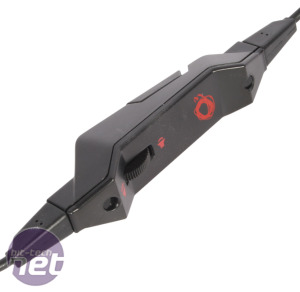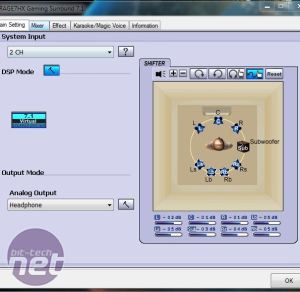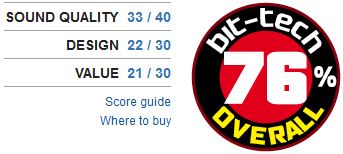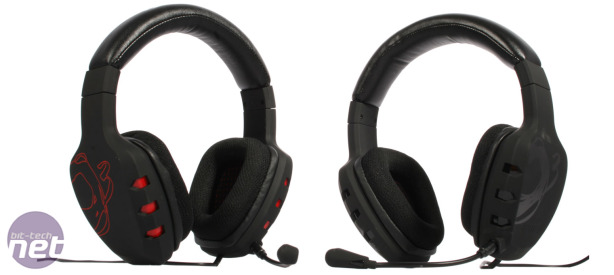
Ozone Rage 7HX and Rage ST Reviews
The Ozone headsets use different in-line controllers, although both are made from cheap and very light plastic. The Rage ST is controlled by an easy to use one designed to be held almost like a lighter with your thumb controlling the volume slider or the microphone mute button depending on the way you hold it.Meanwhile the 7HX controller is quite poorly designed with volume buttons on one side, and mute buttons on the other. It's difficult to press buttons on one side without your grip pressing those on the opposite one, which is really annoying in use. A button to mute the headset is also pointless feature given that you can just turn its volume to zero, and a volume wheel would have been much preferable to the clunky buttons.


Click to enlarge - The remote of the cheaper ST (left) is actually better designed and easier to use than that of the more expensive 7HX (right)
Typically cheap headsets tend to be piercing and tinny, especially at high volumes, which was certainly the case with Gioteck's EX-05. However, when using the Rage ST for the first time, almost the opposite proved to be true and the first thing you notice is that the bass from the 40mm drivers is pretty punchy, especially for a product of its class. In fact, particularly at low and medium volumes, it tends to overpower the mid-range a little, which itself can sound a bit flat and isn't as clear as it could be.
That said, there's no hiss or distortion at the highest volume, and overall we must emphasise that the Rage ST's sound quality is far better than we were expecting. It certainly won't please audiophiles and there are naturally areas in which it could improve, but it's still excellent for its price and we had very few issues with it in general gaming use, where the strong bass works more to its favour.


Click to enlarge - The 7HX software allows you to position your virtual surround speakers, but some men just want to watch the world burn...
With its USB interface, the Rage 7HX can go significantly louder than the ST, although you'll want to keep your system volume clocked at a maximum of 75-80 per cent as above this it starts to sound a bit distorted and unpleasantly loud. It also uses 40mm drivers, but compared with its sibling, the sound produced is definitely better balanced. It's not the best we've heard, but the bass is still powerful and the high-end and mid-range are more apparent and better defined, although it does struggle to pick out the finer details in more distorted songs.
The 7HX headset also comes with software you can use to apply environment effects, adjust EQ settings, switch on the virtual 7.1 surround sound and ludicrously even alter the position and levels of your virtual speakers. The effect can sometimes make music sound a bit more dynamic, and in compatible games it has a slight but noticeable impact on increasing your awareness of where sounds originate from, but it's still naturally no match for true surround sound.
Conclusion
We're really impressed with the Ozone Rage ST. It may be basic, but that's part of its appeal as everything it does it does well and all for less than £30. Its sound and build quality are especially outstanding for so cheap a headset, and if you're looking for a comfortable circumaural headset to simply plug in and play some games with on the cheap then you really can't go wrong.The 7HX is less impressive, however, as it is outclassed by other similarly priced headsets. Corsair's Vengeance 1300, for example, may only use stereo sound, but its 50mm drivers produce a more desirable sound. Also, its leather padded and rotatable earcups are preferable, as is the simple but effective in-line remote. Therefore, while it does improve on the sound quality of the ST, its focus on providing 7.1 surround sound, which isn't all that convincing anyway, hinders it in other areas that need the improvement more.
Ozone Rage 7HX Score

Ozone Rage ST Score

Ozone Rage ST Score

-
Value29 / 30
-
Design24 / 30
-
Sound Quality31 / 40


MSI MPG Velox 100R Chassis Review
October 14 2021 | 15:04









Want to comment? Please log in.